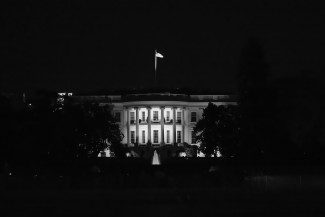
Johns Hopkins UniversityEst. 1876
America’s First Research University
The Relative Nature of “Fake News”: Woodrow Wilson's Fearmongering and the Battle for “Truth”

“Fake news” has become an all-too-familiar phrase since Donald Trump introduced it into the vernacular during his bid for the presidency in 2015-16. Yet the term has a long history, mostly under the name “propaganda.” Today the term is generally defined as lies and misinformation meant to benefit its purveyors. I operated under this same assumption when I began the research for my book Age of Fear: Othering and American Identity during World War I. Depictions of Germans as rampaging beasts, broadsides warning of the Kaiser’s spies peering around every corner, and Woodrow Wilson’s own promise that dissidents would be met “with a firm hand of stern repression” at first appeared to me as cynical, Machiavellian means of manipulating a largely isolationist American populace to act in ways contrary to their will and interests.
Although there is a grain of truth in this, what I discovered is that this assessment actually explains very little about propaganda and why it often appears to work. By considering propaganda at face value, as at least the genuine thoughts and feelings of its creators, one can better understand its nature and intent. In the case of the United States during the First World War, no individual better reflects the nature and intent of propaganda than Woodrow Wilson.
Despite portrayals of Wilson as laser-focused on his crusade to make the world “safe for democracy,” the war raised critical concerns about his own country’s security. Germany’s seeming invincibility in the first weeks of August 1914 appears to have troubled Wilson greatly. On two occasions at the end of that month, the president related to trusted confidants his fear that a German victory would so endanger the nation’s security that “it would change the course of our civilization and make the United States a military nation.” What would happen to democracy if America were forced to militarize for its own protection?

Wilson’s anxiety over an overwhelming German bully did not fade after the U.S. entered the war, as evidenced by his occasional hands-on approach to the work of the Committee on Public Information (CPI), the administration’s propaganda office. A fitting example is his editing of a speech CPI chairman George Creel was to deliver in July 1918. The address was nothing short of demagogic. A decades-long German conspiracy had been afoot both inside the United States and Europe. Millions of Germans immigrants came to America to undermine its democratic traditions and defenses, while the German Kaiser plotted to establish colonies in the New World that could act as future launching points for an invasion of the United States. In fact, Germany’s ultimate aim in the Great War was the subjugation of the United States. In a short note attached to the modified draft of the address, Wilson informed Creel that he “ha[d] taken the liberty of making some alterations in this paper….As altered, I think it is all right.”
Yet perhaps more important than such dystopic and conspiracy-laden representations of the past, present, and possible future is the motivations of men like Wilson and Creel for uttering them. In their minds, they were not spreading falsehoods and half-truths. To them, as Wilson had shown and Creel would reassert on numerous occasions from 1918 to the 1940s, their propaganda was grounded in truth. By educating the American people of the importance of sacrificing in order to defeat Germany—for the sake of their own security—Wilson and Creel believed they were serving the public good.
Their demagoguery was quite impactful in large part because it tapped into pre-existing stereotypes of Germans and other non-Anglo immigrants. Wilson and Creel’s fearmongering propaganda helped stir up a wartime culture of intolerance, which manifested as vigilante violence against German-Americans and wartime dissenters, the creation of a surveillance state, and heavy-handed laws curtailing free speech. It is unlikely that such an oppressive climate would have arisen without a critical mass of the population interpreting propagandists’ “truths” as genuine statements of fact.
As during the first World War, insularity, narrowness, and xenophobia from some of today’s leaders and many media outlets have weakened - not strengthened- the current American body politic. Accepting present-day nativist propaganda as genuine expressions of ideology, paranoia, and fear allows us to better understand the scope of this challenge and the potential consequences of leaving it uncontested. A competition between competing visions of America and American identity is playing out before us, just as it did in 1917-18. The mission of nativism’s opponents is not merely to convince others that their facts are wrong. That may be the easy part. The task is to convince them that they are mistaken about their fundamental beliefs about their country and themselves.
Zachary Smith teaches writing and rhetoric in Birmingham, Alabama. He earned his PhD in history from the University of Georgia. Smith is the author of Age of Fear: Othering and American Identity during World War I.


